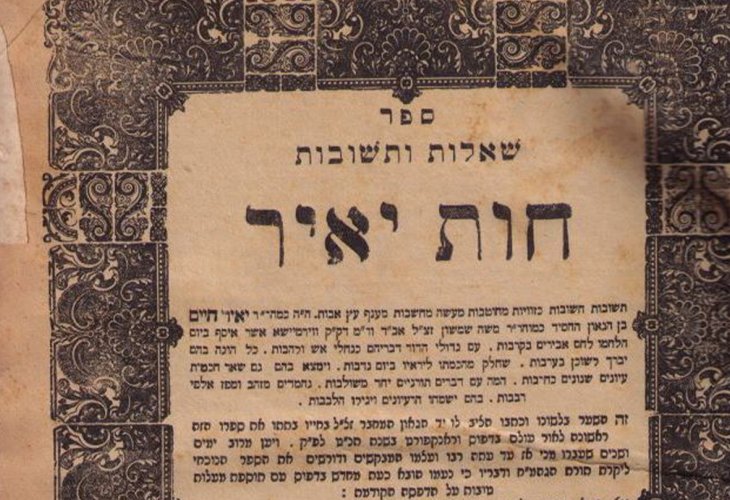Torah Personalities
The Sharp Mind of the Rhine: The Life and Legacy of Rabbi Yair Chaim Bacharach
Author of Chavot Yair and rabbi of historic Worms, he shaped halachic (Jewish legal) discourse with brilliance, courage, and devotion to Torah

A Torah Legacy Rooted in German Jewry
In the month of Tevet 1702, Rabbi Yair Chaim Bacharach, known by the title of his most famous work, Chavot Yair, passed away. In his final years, he served as the rabbi of Worms, one of the oldest and most storied Jewish communities in Europe.
The title Chavot Yair is not only a nod to the biblical Chavot Yair (Bamidbar 32:41), but also a tribute to his mother, the scholarly Rebbetzin Chava Bacharach. A granddaughter of the Maharal of Prague and daughter of Rabbi Yitzchak Katz, one of the foremost rabbis in Germany, she was renowned in her own right. Her brothers, Rabbis Naftali Katz and Chaim Katz, were also respected Torah scholars.
Rebbetzin Chava was famous for her Torah knowledge and would engage in halachic (Jewish legal) discussions with her father’s students. After the early passing of her husband, she raised her gifted son, Yair Chaim, on her own, guiding him in Torah and mitzvot. Many Torah insights were attributed to her in the Jewish communities of Germany.
Although Rabbi Yair Chaim wrote around forty works, he is best known for Chavot Yair, his collection of halachic responsa. The work is marked by sharp reasoning, striking clarity, and complex mathematical calculations applied to Jewish law. One notable responsum (Siman 150) recounts a harrowing personal experience involving a halachic dilemma related to kilayim (forbidden mixtures), which he faced as a young man traveling through the Black Forest.
A Halachic Dilemma in the Snow
The Jewish communities of the Rhineland—Speyer, Worms, and Mainz—were nestled along the Rhine River in what is now the tourist-rich Black Forest region of Germany. Today the area boasts highways and cable cars, but in Rabbi Yair Chaim’s time, winter travel was treacherous.
In his responsum, he recounts a journey from his in-laws’ home in southern Germany to his own home in Worms. As the wagon ascended Mount Feldberg en route to Frankfurt, the driver realized that the two horses were not strong enough to pull the wagon through the snow. He borrowed an ox from a nearby village to help, but Rabbi Yair Chaim immediately recognized a potential halachic issue: the Torah forbids harnessing an ox and a donkey together (kilayim), and the rabbinic consensus extended concerns about mixing different animals for labor.
In vivid detail, he describes his helplessness:
“As I traveled through Mount Fagelshberg during the rainy season, the two weak horses could not climb the hill. The driver borrowed a large ox from the village of Geislingen to pull the wagon for an hour. I was young and alone, and although I pleaded with the driver, he refused, saying it was impossible otherwise. I lacked the strength to walk on foot and remained seated in great distress, for it was almost life-threatening.”
Though this incident occurred in his youth, Rabbi Yair Chaim went on to become a towering halachic figure and eventually assumed the prestigious rabbinic post of Worms, a city steeped in Torah history.
Worms, Torah, and Eternal Rest
Worms was a spiritual capital of Ashkenazi Jewry. Its ancient synagogue, where Rashi studied in his youth, still stands today. Visitors are shown a niche in the wall believed to mark the site of a miracle involving Rashi’s mother, who was nearly trampled by a horseman in the Jewish quarter. The synagogue remained active until Kristallnacht in 1938, when it was burned. It has since been restored and is in use once again.
Rabbi Yair Chaim Bacharach was buried in the Jewish cemetery of Worms, which holds thousands of graves dating back to the era of the Baalei Tosafot and the Crusades. Among the great figures buried there are Rabbi Yosef HaBachur, the Maharil, the Maharam of Rothenburg, and Alexander ben Salomon Wimpfen, the philanthropist who redeemed the Maharam from captivity, alongside many of the giants of medieval Ashkenaz.
Rabbi Yair Chaim Bacharach embodied the intellectual strength, halachic rigor, and spiritual depth of German Jewry. His legacy continues to guide Torah scholars and his works remain central to halachic discourse.

